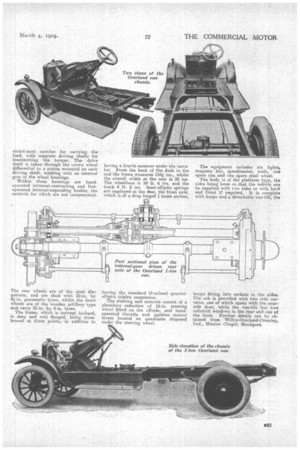A NEW 1-TONNER FOR THE BRITISH MARKET.
Page 14

Page 15

If you've noticed an error in this article please click here to report it so we can fix it.
The Latest Overland Model now in Production at the Company's Works at Heaton, Chapel.
TH E OVERLAND 1-ton truck 1 chassis, the first batches of which are now commencing to flow through the great works at Heaton Chapel, near Manchester, has already attracted a.good deal of attention, as one may judge from the number of orders and inquiries being received at the works.
The chassis, whieli costs £198, has a weight of 161 cwt. (the body weight being 7 cwt.), and incorporates a standard Overland engine of 2,230 c.c., E.A.O. rating 18.2 h.p., three-speed gearbox (centrally controlled) and a Russell-type double-reduction internal rear-drive axle. The whole vehicle is substantially made, the preliminary 16,080-mile test to which the first 1-tonner was subjected under a load of 25-30 cwt. having revealed a remarkable absence of wear and .a petrol consumption of something like a gallon per 30 miles. . .
The engine incorporates an Auto-life starting motor and generator, a detachable head and a four-cylinder 'monobloo
casting. Ignition iS by _highjension magneto, and lubrication by Centrifugal feed, the water being-circulated Ihernapi siphonical ly. A' single-plate'clutch transmits the power to 'the—gearbox, which forms a c4linuilete.eunit zwith the engine, and provides three speeds and reverse gear with central change and ad
20 justable pedals for clutch and brake. Large annular ball bearings are used throughout the box, which has stub toothed-type gears of the selective sliding variety made of heat-treated nickelsteel. The petrol tank, which accommodates gallons of fuel, is located in the dash, and feeds the Tillotson carburetter by gravity. The back axle, which we illustrate, has a double-reduction internal gear drive and a heavy, solid chrome nickel-steel member for carrying the load, with separate driving shafts for transmitting the torque. The drive itself is taken through the crown wheel differential to a pinion mounted on each driving shaft, meshing with an internal gear in the wheel housings.
Within these housings are handoperated external-contracting and footoperated internal-expanding brakes, the controls for which are not compensated.
The rear wheels are of the steel disc pattern, and are shod with 32-in. by 40n. pneumatic tyres, whilst the front wheels are of the wooden artillery type and carry 31-in. by 4-in. tyres. The frame, which is inswept forvard, is deep and well flanged, being crossbraced at three points, in addition to having a fourth member under the radiator. From the back of the dash to the end the frame measures 1344 ins., whilst the overall width at the rear is 33 ins. The wheelbase is 10 ft. 6 ins, and the track 4 ft. 8 ins. Semi-elliptic springs are employed at the Aar, the front axle, which is of a drop forged I beam section,
havingthe standard Overland quarterelliptic triplex suspension.
The steering and controls consist of a planatory reduction of I6-in, steering wheel fitted on the offside, and handoperated throttle and ignition control levers located on quadrants disposed under the steering wheel.
The equipment includes six lights, magneto key, speedometer, tools, one spare rim and one spare steel wheel.
The body is of the platform type, tht sides being loose so that the vehicle can be supplied with two sides or with back and front if required. It is complete with hoops and a detachable van-tilt, the hoops fitting into sockets in the sides. The cab is provided with two side curtains, one of which opens with the nearside door, while the van-tilt has two celluloid windows in the rear and one at the front. Further details can be obtained from Willys-Overland-Crossley, Ltd., Heaton Chapel, Stockport.






























